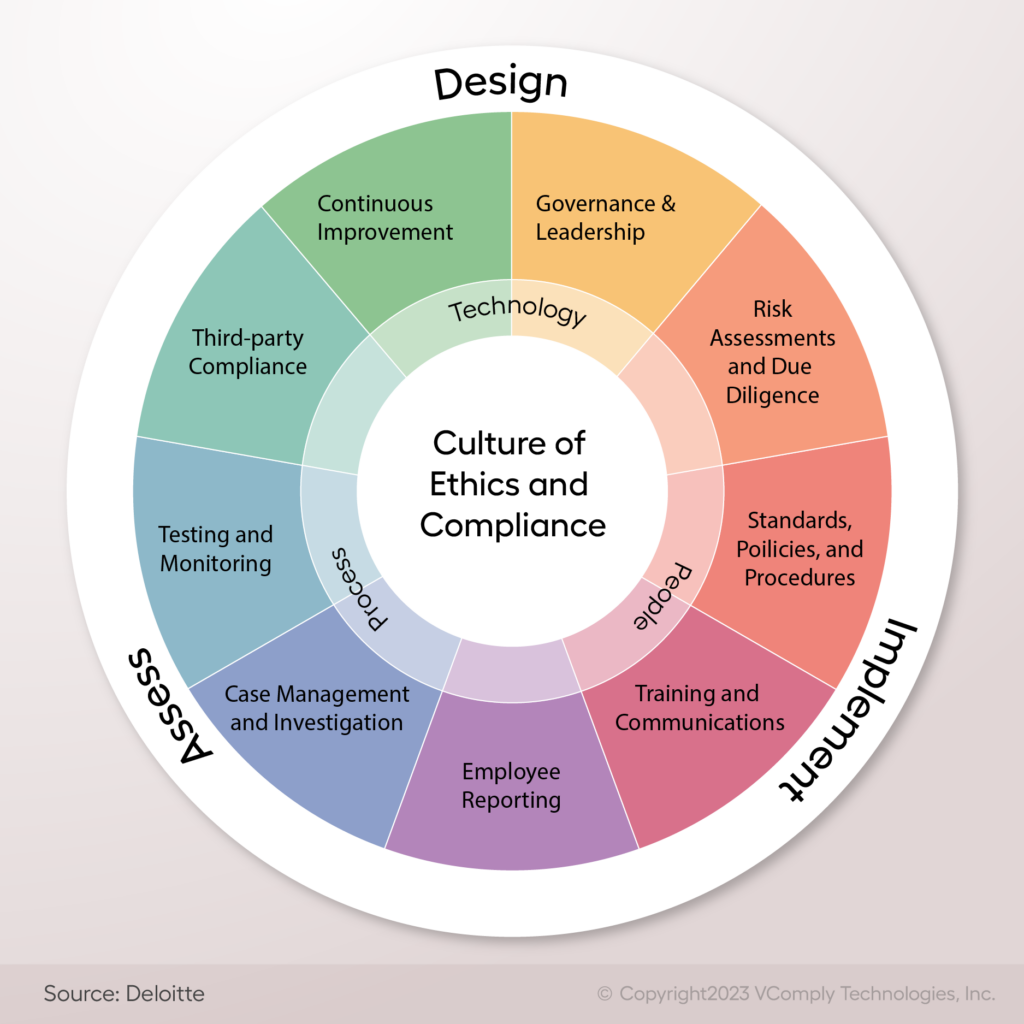People, Process, and Technology: The Three Pillars of Effective Compliance Management
Organizational exposure to compliance risk is increasing consistently while compliance costs are skyrocketing. A reactive approach to compliance creates complexity and forces organizations to be less agile. Previously, organizations viewed compliance as discrete obligations and created multiple siloed initiatives to meet the objectives. These initiatives typically rely on manual compliance management processes burdened with costly assessments managed using error-prone spreadsheets, documents, and email. This reactive methodology makes adapting to new regulatory requirements and changing business environments difficult.

Effective compliance management requires a common compliance risk management process, information, and technology architecture tailored to the organization’s strategy and operational risk management. Compliance must be an integral part of the organization and culture that can identify and prevent problems as an ongoing process that must be monitored, maintained, and nurtured in the context of governance, risk, and compliance management.
This article will discuss the three pillars of an effective compliance management program that complete the entire paradigm – people, process, and technology.
The Importance of People, Processes, and Technology in Compliance Management
With the constantly rising risk factors and challenges as well as regulatory changes a business faces, the compliance management process is no more sidelined as a mere obligation, rather it has become a critical solution to navigate the challenging times as a consolidated, systematic framework helps organizations avoid high penalties, security breaches, and incorrigible reputational damage.
To safeguard an organization, the compliance management framework must be covered in all three aspects – people, process, and technology.
Where do People Fit in the Compliance Management Strategy?
A compliance function starts with people. For organizations, people can be the greatest asset or the biggest burden in managing compliance. They play a pivotal role in any compliance management strategy, serving as the linchpin that ensures its effectiveness. They are responsible for understanding, implementing, and upholding regulatory requirements within an organization, making their engagement, training, and commitment essential components of a robust compliance framework.
Management can work with employees in 4 ways to develop a sound compliance management culture:
Identity, Roles, and Access Management
Define roles for different users in your environment, from administrative assistants to the CEO, and set physical and logical access rights for all employees. After defining these roles, make sure they have the appropriate access.
Define Everyone’s Accountability
Make everyone responsible for compliance. Successful organizations’ management understands that their organizations need to address much more than just trivial IT security issues, and everyone needs to contribute to that.
Training and Awareness
Develop proper training and awareness programs for your employees. Employees outside of compliance teams may not be aware or even bothered by information risk management. It becomes the job of the compliance officer and compliance leadership to keep them engaged, interested, and informed about security and holistic compliance programs.
Building a Culture of Compliance Management
To be effectively compliant, you must create internal policies that reflect the best in the industry. Building a culture characterized by standards motivates the team to excel in quality. Establish policies that conform to compliance management standards. Merge internal policies with a compliance plan and ensure that every employee thinks about compliance as a part of their KRA, not just a business exercise.
Where do Processes Fit in the Compliance Management Strategy?
How you approach compliance management depends on the standards you need to meet, stakeholder buy-in, and available resources. Understanding and mapping these elements serve as the basis for the compliance plan and define roles, responsibilities, and processes accordingly.
Processes are integral to a compliance management strategy as they provide the structured framework through which an organization can achieve and maintain adherence to regulatory requirements and industry standards. These processes encompass a wide range of activities, including risk assessment, policy development, monitoring and auditing, reporting, and corrective actions. Each step in these processes is meticulously designed to ensure that an organization identifies, addresses, and mitigates compliance risks effectively. Moreover, processes help in creating a culture of accountability and transparency within the organization, promoting a systematic approach to compliance management.
One of the key roles of processes in compliance management is to streamline the flow of information and tasks across various departments and teams. They serve as a roadmap for employees, guiding them through the necessary actions and decision-making required to maintain compliance. These processes also aid in documentation, record-keeping, and the creation of an audit trail, which is essential for demonstrating compliance to regulatory authorities and stakeholders. Ultimately, well-defined and executed compliance processes are essential for ensuring that an organization consistently meets its obligations while minimizing the potential for regulatory breaches and associated risks.
The compliance management processes take care of the entire paradigm of compliance and risk management, organization structure, and how systematically and methodically your approach would be to counter the threats.
To understand what you need to do to develop a compliance management plan, you should know that you need to do the following:
- Consider potential risks in the product life cycle
- Convey the importance of compliance management to all stakeholders: board members, the leadership team, and employees
- Assign responsibilities properly
- Create compliance management workflows so that the processes are repeatable
- Take cognizance when violations occur and take appropriate actions to mitigate them
Processes should address internal and external business risks, with appropriate frameworks to deal with both external attacks and internal threats.
An important question worth answering is: Do you have processes in place that accommodate both proactive and reactive approaches? Being proactive in preventing risks and reactive in responding should an incident occur.
Where does Technology Fit in the Compliance Management Strategy?
Technology is paramount in an effective compliance management program, but it must be used appropriately. A compliance management framework is incomplete without the right tool. Compliance management software aids in improving the efficiency of its operations and expanding its ability to manage and monitor the organization’s compliance risks. Some key areas where technological tools can be of particular use:
Compliance Risk Repository
One of the most fundamental uses of compliance management software is a repository of the compliance risks faced by the organization and the supporting details of each risk. It works as a point of reference for the organization whenever a new risk factor emerges. It generally includes:
- Description of compliance risk
- Relevant laws or other control regulations
- Business units/functions potentially affected
- Core elements of the program
Control Automation Using Workflows
Internal control automation using workflows involves leveraging technology to automate the management and control of organizational activities. This is achieved by utilizing workflow software to create a series of automated tasks designed to ensure specific control objectives are met. For instance, workflows can be implemented to automate internal controls and reminders to ensure compliance with established policies and procedures. By automating these tasks, organizations can minimize the risk of human error, increase operational efficiency, and enhance the accuracy of their reporting. Additionally, workflow automation provides a transparent audit trail that can be utilized to demonstrate conformity with regulatory requirements and internal policies. Ultimately, internal control automation using workflows is a powerful means of improving the efficiency and effectiveness of organizational control processes.
Insights and Analytics
Compliance issues often arise not only because of negligence from the management but also from the ineffective management of the available data and the inability to identify the risk factors. The problem is that the amount of data can be overwhelming, and linking the dots between related data items and sources can be challenging. This is where compliance tools like VComlpy’s GRC platform can be of great help. With VComply, the compliance function can consolidate and analyze data from different parts of the organization to identify deviations from the norm or outliers in time that could indicate a compliance issue in the near future.

Best Practices for Building a Winning Compliance Management Program
A thorough compliance management system can be the biggest differentiator between successful and failed organizations in the present times. A compliance management program safeguards your organization from potential risk factors or emerging risks and compliance challenges. But building a compliance management program from scratch can be quite daunting. Here are the steps for building a successful compliance management program for your organization.
Conduct a Comprehensive Risk Assessment:
In most industries, regulatory standards are well-defined and serve as the basis of the compliance plan. Having said that, some hidden risk factors always emerge at later stages and might be critical to the compliance process. Based on your existing threats and business knowledge, you need to have a thorough compliance risk assessment plan ready to identify, monitor, and mitigate potential errors and threats.
Establish Company Policies and Procedures:
Compliance management is a top-down initiative where the leadership actively participates, and everyone becomes an equal stakeholder for regulatory readiness. Your compliance team will assume most of the responsibility for achieving and maintaining compliance. However, your program fails to reach its true potential without top-down buy-in.
Create a policy outlining the compliance-related roles and responsibilities for each department and team in your organization. In addition to this, set clear deadlines so your employees know what and when the outcomes are expected of them.
Communicate the Plan and Provide Training:
Remember that the greater the risk, the more intensive attention should be given to detail. Help employees understand the severity of compliance management and make the training simplistic for holistic inclusion. This can mean anything from bilingual training to providing concrete examples backed by use cases.
Adopt a Risk-Based Approach to Compliance Management:
A risk-based approach to compliance and ethics management involves identifying, assessing, and uncovering organizational high-priority risks. As a best practice, risk-based compliance programs enable organizations to capture, consolidate, and centralize risk management based on standards, controls, and actions.
By applying a risk-based approach across the organization, GRC professionals can present best practices to highlight the most serious compliance risks across the organization and showcase actions taken to mitigate issues, violations, investigations, and fines.
A standard risk-based approach includes:
- Keeping up with standards
- Ensuring that all employees understand the requirements
- Align business functions with compliance
- Identifying and rectifying violations as they happen to enhance the process
- Review processes and procedures at regular intervals
Invest in Compliance Management Software:
Catering to every risk factor and each potential error manually is an impossible task. With the constantly rising stakes, there is negligible room for error and experimentation. In such a pressing scenario, compliance management software like VComply can proactively manage the three critical aspects of your business: people, processes, and technology.
You should look for the following capabilities while going for compliance management software:
- Customizable according to the compliance obligation to meet your objective.
- You should be able to manage your compliance programs across multiple locations or business functions.
- You can generate user-friendly, real-time reports from unified dashboards.
Conclusion
Though it might seem difficult and gruesome at a glance, you can strike a balance among all three components of the compliance management program with the help of a GRC platform. An effective compliance management framework can help you strategize in advance, safeguard your organization from heavy penalties, and build your credibility in the industry.
